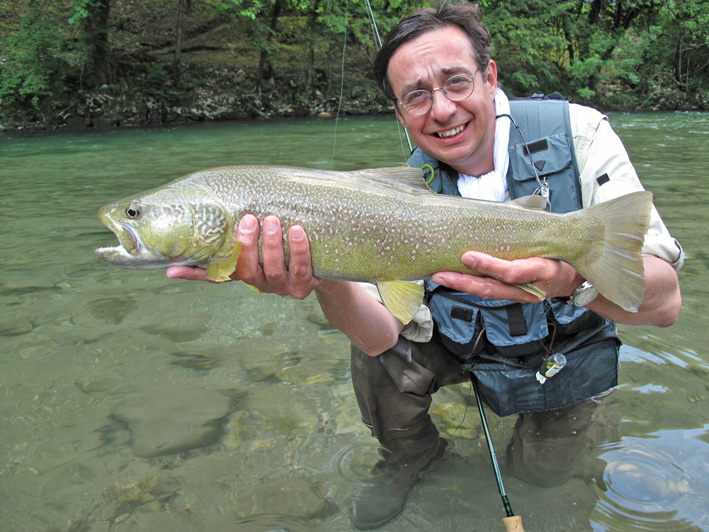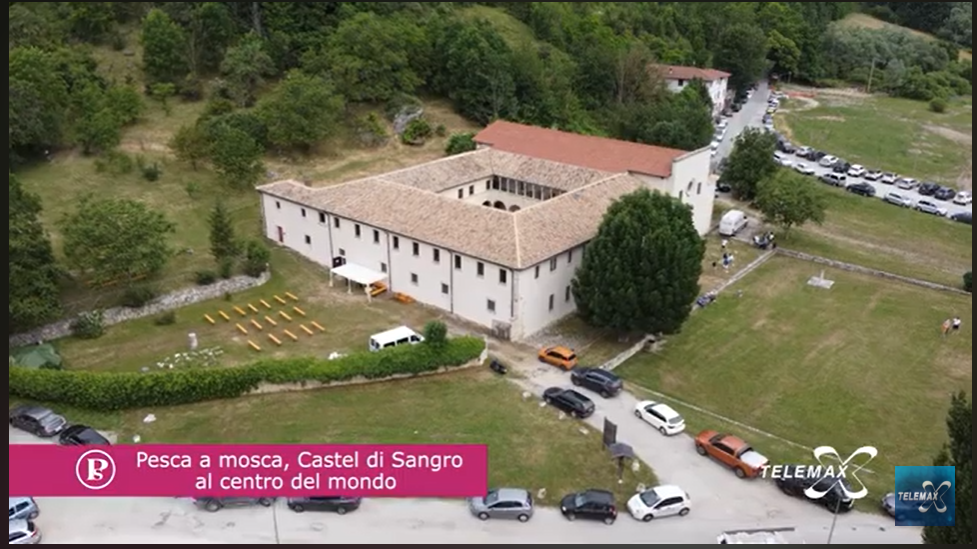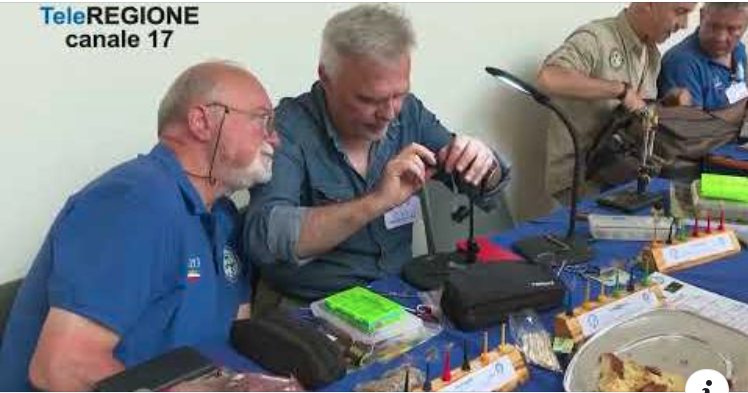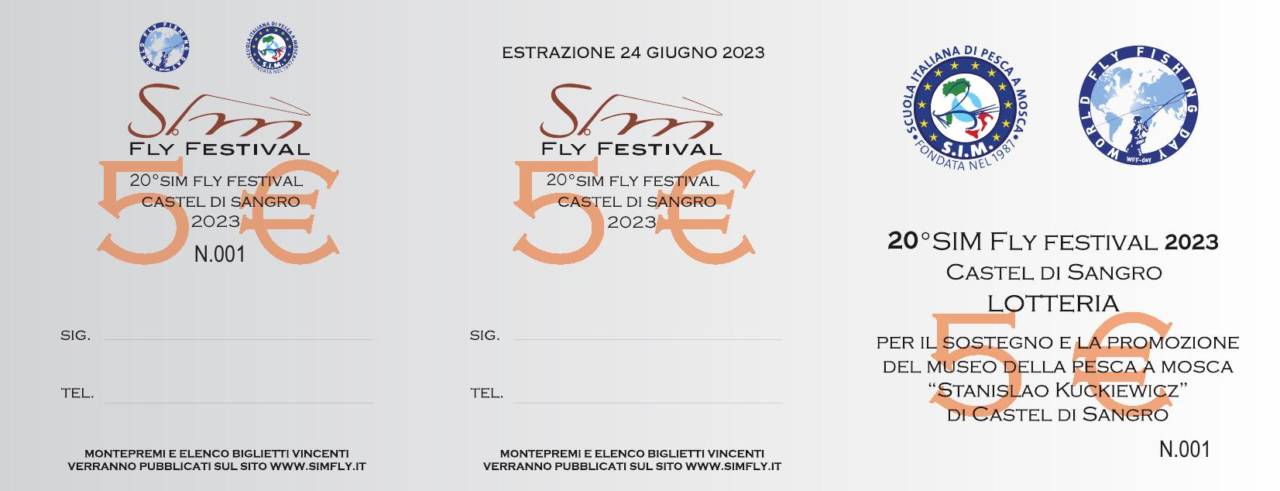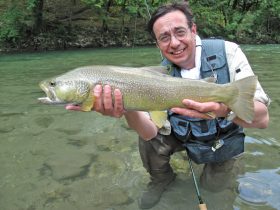 Imparai a pescare come i ragazzi di « In mezzo scorre il fiume ». Quasi 35 anni fa, quando avevo 7 anni, mio nonno mi portò a pescare per la prima volta. In Francia, dove vivevamo, potevo pescare piccoli pesciolini mentre anni più tardi, con braccia più forti, catturai la prima trota, lo ricordo come ieri. La canna era lunga 4 metri, fatta in bamboo, e l’esca era una vera mosca di maggio che doveva essere maneggiata con cura come fosse un fiocco di neve.
Imparai a pescare come i ragazzi di « In mezzo scorre il fiume ». Quasi 35 anni fa, quando avevo 7 anni, mio nonno mi portò a pescare per la prima volta. In Francia, dove vivevamo, potevo pescare piccoli pesciolini mentre anni più tardi, con braccia più forti, catturai la prima trota, lo ricordo come ieri. La canna era lunga 4 metri, fatta in bamboo, e l’esca era una vera mosca di maggio che doveva essere maneggiata con cura come fosse un fiocco di neve.
La mia prima esperienza con la pesca a mosca fu con una canna di bamboo di mio nonno e con una vecchissima lenza che doveva essere ingrassata ogni 5 o 10 lanci. Non era un modo efficiente per catturare un pesce ma imparai lo stesso molto. CI spostammo in Svizzera nel 1978 ed ebbi il primo contatto con il CDC. Ero ad una festa con amici
quando l’amico Bruno, che non ci vedeva bene, mi chiese di costruire una mosca visibile e che galleggiasse bene. Poiché ero molto felice di quella richiesta ma non volvo perdere la faccia, iniziai a studiare le mosche locali in cdc. Quelle mosche usavano il cdc per le hackle e non per le ali, con corpi in seta. Non volendo copiare quei modelli iniziai a sviluppare un mio concetto costruttivo e a montare anche i corpi in cdc. Potevo formare corpi conici che galleggiavano anche in acque mosse. Bruno, e poi molti altri pescatori in Europa, fu molto soddisfatto con quel nuovo modo di costruire mosche. Sono stato un costruttore professionista dal 1990 e oggi sono molti i pescatori che credono che quella piccola piumetta sia il meglio che si possa avvolgere ad un amo. Sono perfette per secche, emergers, ninfe, streamer e persino per mosche da salmone e da mare. Le amo e così penso anche voi.
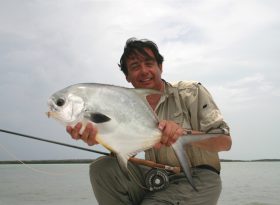 I learned to fish like the kids in the great movie “A River Runs Through It”: Nearly 35 years ago – when I was a seven year old boy – my grandfather took me fishing for the first time . In France where we lived. I was allowed to catch little baitfish. Some years later – and with stronger arms – I caught my first trout and I remember it like yesterday. – The rod was 4 meters long, made out of Bamboo and the bait was a natural may-fly (Ephemera danica, imago) which had to be handled as carefully as a snow-flake. My first experiences of fly-fishing used an old split-cane rod of my grandfather and an even older line which had to be greased every five or ten casts! This was not a very efficient way to catch fish, but I learned a lot! In Switzerland, where I moved in 1978, I had my first contact with a cdc-fly. It was at a dinner among fishermen when my friend Bruno – who had poor eyesight – asked me to tie him a visible fly which floated nicely. Because I was very proud of that request and did not want to lose face I began a study of local cdc-flies. Those patterns used cdc-hackles, no wings and classical bodies made of silk or other materials. Worried, not wanting to copy those local flies, I developed a new concept of also tying the body with a cdc-feather: This product a perfect conical body, which floated even in riffles and rapids. Bruno and later many more fishermen in Europe, were very pleased with the simple but efficient new way to tie a fly. I have been a professional fly-tier since 1990 and today more and more anglers are convinced that those tiny and inconspicuous feathers are the best a fly fisherman can have wrapped around a hook: They are good for dry-flies, for emergers, for nymphs, for streamers and even for salmon flies or saltwater-patterns. I love them and think you will too!
I learned to fish like the kids in the great movie “A River Runs Through It”: Nearly 35 years ago – when I was a seven year old boy – my grandfather took me fishing for the first time . In France where we lived. I was allowed to catch little baitfish. Some years later – and with stronger arms – I caught my first trout and I remember it like yesterday. – The rod was 4 meters long, made out of Bamboo and the bait was a natural may-fly (Ephemera danica, imago) which had to be handled as carefully as a snow-flake. My first experiences of fly-fishing used an old split-cane rod of my grandfather and an even older line which had to be greased every five or ten casts! This was not a very efficient way to catch fish, but I learned a lot! In Switzerland, where I moved in 1978, I had my first contact with a cdc-fly. It was at a dinner among fishermen when my friend Bruno – who had poor eyesight – asked me to tie him a visible fly which floated nicely. Because I was very proud of that request and did not want to lose face I began a study of local cdc-flies. Those patterns used cdc-hackles, no wings and classical bodies made of silk or other materials. Worried, not wanting to copy those local flies, I developed a new concept of also tying the body with a cdc-feather: This product a perfect conical body, which floated even in riffles and rapids. Bruno and later many more fishermen in Europe, were very pleased with the simple but efficient new way to tie a fly. I have been a professional fly-tier since 1990 and today more and more anglers are convinced that those tiny and inconspicuous feathers are the best a fly fisherman can have wrapped around a hook: They are good for dry-flies, for emergers, for nymphs, for streamers and even for salmon flies or saltwater-patterns. I love them and think you will too!
 Scuola Italiana di Pesca a Mosca – S.I.M. – Corsi di Pesca a Mosca per principianti ed esperti – Corsi di apprendimento, perfezionamento e stage per Istruttori
Scuola Italiana di Pesca a Mosca – S.I.M. – Corsi di Pesca a Mosca per principianti ed esperti – Corsi di apprendimento, perfezionamento e stage per Istruttori

